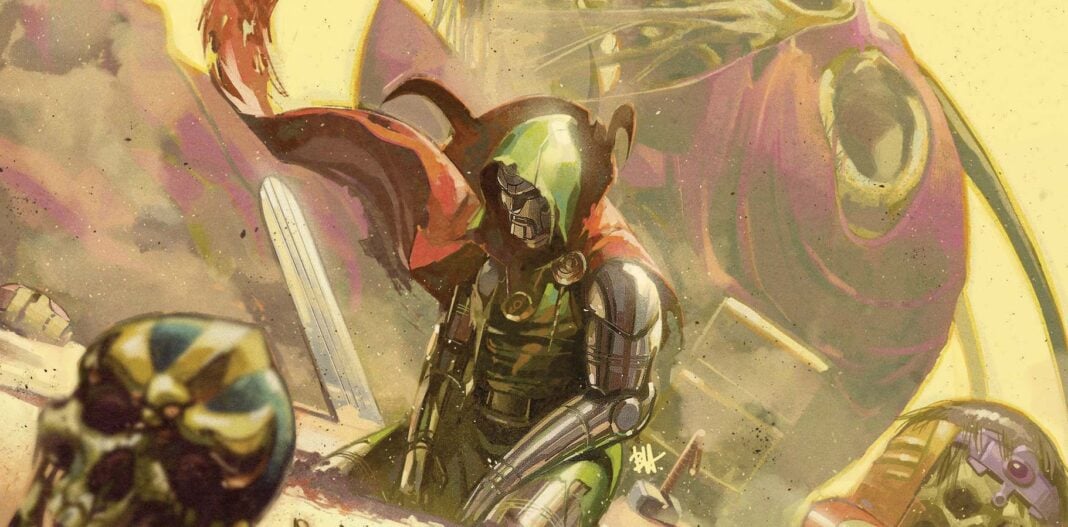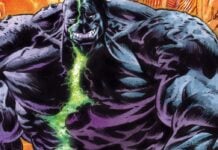This week’s Marvel Rundown looks at the conclusion of the nearly year-long saga of One World Under Doom from Ryan North, R.B. Silva, and David Curiel. Plus, our Rapid Rundown includes Captain America #5, Godzilla Destroys the Marvel Universe #5, and more dispatches from the Age of Revelation.

One World Under Doom #9
Writer: Ryan North
Artist: R.B. Silva
Colorist: David Curiel
Letterer: VC’s Travis Lanham
Let this review be my formal apology to Ryan North. It was around issue 4 where I began to tune out from One World Under Doom, unconvinced that the story was capable of the trenchant political commentary it seemed to strive for. Of course, it was right around then that North revealed the dark Omelas bargain at the heart of Doom’s utopia. The second half of One World Under Doom tears down everything that seemed so bright and shiny and promising, culminating in the shocking ending of issue 8 that sees the one person Doom actually cares about other than himself dead at Doom’s hand.
Maybe it hasn’t all worked as a “linewide event” that the entire Marvel publishing line turns on like the tightly marshaled events of the Bendis-era, when shadow president Norman Osborn and the Dark Avengers invaded every facet of the line, but that ultimately makes little material impact on the story within these nine issues. There are minor details here and there that we miss out on but none of them matter to the central story of Victor Von Doom. And it’s all stripped away in this finale which follows Victor in his desperate quest to save his goddaughter. In the final moments, as Doom makes his last demand to Reed Richards, it’s hard not to feel like we’ve come to the end of one of the best Dr. Doom stories.
North and artist R.B. Silva have shown us the full complexity of Victor Von Doom, in all of his virtues and flaws. Any good he does is ultimately in service to his own need to be perceived as magnanimous and strong. He is an empty husk–visualized literally here in the end by Silva. We have seen what good Doom is capable of, but more importantly, we have seen the deplorable depths of evil he will go to in order to impose his will and foster the adulation he craves.
Silva’s talent for depicting scale through perspective and layout shines in this final issue, which sees Doom taking a journey through the cosmos. He takes what amounts to pages of captions and conversation and creates something epic and fantastical. David Curiel’s colors have been a force throughout the series, creating a color script that adds to emotion and the ebb and flow of the power dynamics. Doom’s triumphant, green flame is stripped away in this issue, and he is at turns abandoned to stark white space, a speck among the cosmos, or draped and huddled in the shadows. Likewise, VC’s Travis Lanham built out a powerful, baroque lettering for Doom that is stripped away by issue’s end.
Like the best crossover events, One World Under Doom’s ending brings with it new story opportunities and status quo. It remains to be seen how much of what North lays down, with governments in disarray and a faction of the populace still devoted to Emperor Doom, is picked up, but there are threads to follow. More overtly, the finale sets up future Fantastic Four and Scarlet Witch stories, both of which I am excited to read.
But I’m not the only one with thoughts on this week’s finale. Fellow Marvel Rundown contributor George Carmona 3rd offered a bit of a different perspective on the finale. In dedication to Radio Rahim, GC3 shared his love/hate reaction to the series, writing:
- “Earlier this year, the crew of the Marvel Rundown did a Roundtable on One World Under Doom, and we all came to the conclusion that it’s Doom’s world to lose, and writer Ryan North, along with artist R.B. Silva, brought the point home. Here we are again with a tight concept, high-caliber execution, and a predictable result. The best things this series has done is give voice to the madness that is current US history and set up the next Marvel event.”
I echo George’s thoughts that One World Under Doom is a trenchant commentary on a disorienting moment in US history. It explores the cost of strongman politics, and the devil’s bargains required by each individual member of society to overlook the moral and human cost of personal security. Perhaps the ending was predictable–bad guys always lose eventually in superhero comics–but the journey has been compelling. So, once again, I apologize to Ryan North. In the end, One World Under Doom is the best of what superhero stories can be: big, bombastic action that grapples with themes both personal and profound, while examining and reflecting the real world.
VERDICT: BUY
THE RAPID RUNDOWN
- Godzilla Destroys the Marvel Universe #5
- Godzilla Destroys the Marvel Universe #5 has arguably one of the coolest concepts possible. Writer Gerry Duggan and artists Javier Garron & Scietronc bring the fight to Godzilla with a combination mecha that utilizes every aspect of the Marvel universe. From Pym Particles to make Magik’s sword bigger, Cyclops rays powering the mecha, and Vibranium web shooters, the whole thing is one of the most incredible things I’ve seen this year in terms of comics. The fight culminates in an epic spread that is a real feast for the eyes and makes the build-up of the last issues feel worth it. The plan to get rid of Godzilla is a smart one, too, one that could only happen thanks to every Avenger, X-Men, and Fantastic Four member available. If Godzilla Destroys the Marvel Universe ended here, it’d be a satisfying crossover that brought some funny panels and great fight scenes. But the writers take it one step further by teasing a possible sequel, all by flipping the hero’s plans on its head and presenting an even bigger Godzilla-like problem to solve. Here’s hoping Duggan and his artists can continue the run in a future mini-series. Hopefully, Godzilla can cause more permanent damage in the future run, leaving lasting marks that really show just how fierce the kaiju is. Besides that, this run has been a fun one overall, and I can’t wait for more. – LM
- Captain America #5
- Captain America #5 wraps up the first story arc from Chip Zdarsky and Valerio Schiti and let me offer an apology on my review of issue #1. Seeing the set up for the David Colton Captain America, and given that a good number of superhero writers take the easy way out by assuming anyone with power would automatically become a monster, I took the easy out as a reviewer. I assumed we were getting another evil Cap. I could not have been more wrong. Instead these five issues allowed Zdarsky to present a story about the complexities of being Captain America, what makes Steve Rogers a hero he is, and a critique on American interventionism. He ends this story how he opened; with the damaged 9/11 Captain America David Colton sorting out his feelings and Steve Rogers trying to figure out what he needs to be in this modern world. Colton has been more interesting than he should be on the surface. While memories of American involvement in World War II are portrayed as pure things, 9/11 left a divided, scarred nation in its wake. The wars in Afghanistan and Iraq destabilized regions that even today have not recovered. A generation of young men came out of both theaters of conflict unprepared for what they left behind and Colton is no different. He’s a hero in his heart but his actions have been brutal and reactionary. It’s a fascinating contrast with a Steve Rogers retconned into waking up in post-9/11 America. Aiding in this moral complexity is the art of Schiti and colorist Frank Martin. Their work on this issue is moody and stark. Schiti’s use of shadows only heightens the uncertainty that Rogers feels in this new world he’s now in. But he also can draw a killer action scene like Cap’s fight with Doom in this issue or Colton’s rampage against the American forces. Martin’s color work should be commended from the spot red at a moment of extreme violent to the way he deploys orange on the reveal of Rogers coming onto Colton’s rampage. This is a beautiful comic to look at. But under that art all are the questions that drive truly great Captain America stories; what shold Captain America stand for in the modern world? Excitingly, the answer is not that easy to parse.- DM
DISPATCHES FROM THE AGE OF REVELATION!
- X-Men: Book of Revelation #2
- Look, I am still at a loss trying to figure out what the core book for the Age of Revelation is supposed to be. Obviously it is supposed to be the one written by Jed MacKay but between X-Men: Book of Revelation and Amazing X-Men, I feel like Amazing is the most like the core book. That said Book of Revelation is definitely an important title to get the scope of the event. In X-Men: Book of Revelation #2, we get more about Doug’s rise to power and the brewing conflict between him and Apocalypse. MacKay answers the important question of “Why did Doug’s friends let him take over?” To be clear, Doug’s amplified powerset pretty much compels people to obey, but still. The issue is about the conflict between Kitty Pryde and Doug, as well as the palace intrigue that drives the impending fall of Revelation. The story is fine and well-paced with great character moments, and MacKay does some interesting things with unreliable story telling between Kitty and Doug. Also, Fabian Cortez is given a fate worse than death that does well to show how scary Doug’s powers have become. Netho Diaz’s art is fine here, but some facial expressions are stressed beyond recognition. It feels like Diaz was rushed to finish the issue. Additionally, the page layout technique Diaz used in the last issue, this faux-panel overlay, is used here again. It looks nice but overcomplicates the page. Book of Revelation #2 is a solid issue that provides some context, but the art hiccups hold it back. I am still enjoying Age of Revelation, even if I can’t get a real feel for the plot two months into this three-month event. –JJ
- Unbreakbale X-Men #2
- Unbreakable X-men #2 continues the side story set in the Age of Revelation about the Uncanny X-Men team battling the ancient horror Shuvahrak. This series has been more about a possible outcome of Gail Simone’s Uncanny X-men storylines. In that regard, it’s a well-executed and emotionally charged issue. Simone’s talent for making a desperate team of heroes work together really shines here as well as her characterization of Gambit. There is a possible continuity gaffe as Deathdream (who is shown to be living at the site of the X-Mansion in Graymalkin and is killed) is now shown living in Istanbul, Türkiye and visually very different. Deathdream can come back from the dead, but it does through some simple month to month continuity up in the air. That aside, this was a great issue for the Outliers coming back together to defeat great evil. CF Villa delivers it in the art in capturing the emotional weight of the moment as well as capturing the kinetic energy of the action. This side story hasn’t had any real bearing on the events so far and barely feels connected to Age of Revelation in general, but it is still a good read and worth checking out. –JJ
Not enough rundown for you! Be sure to read past reviews from the Rundown team!














The plot doesn’t make sense. North should have had Doom deal with the metaphysics of the situation—located Valeria’s soul and talked to Death (who is stuck inside an Infinity Stone). Instead, he wastes space on the Vishanti sequence and then has Doom turn to the Living Tribunal, for no apparent reason other than it’s there and powerful in a cosmic sense. It’s a cosmic administrator, not a god who’s worshipped. Why should it be able to reverse Valeria’s death?
The “cost” factor is a kludge that’s essential for North’s plot, but it doesn’t fit with the practice of sorcery. Gods might require worship, but they don’t charge worshippers for favors (see Dr. Strange stories). The plot material is self-contradicting. The time delay for Doom’s demise is obviously artificial.
Steve Orlando has apparently decided that white space is the best explanation for a problematic situation. He used it at the end of the Vision & Scarlet Witch miniseries to “explain” how the Scarlet Witch did various things, such as erasing data from the Vision’s memory. In this comic, the white space requires fans to invent their own explanations for how Wanda got the things. My explanation is that Orlando is incompetent.
Comments are closed.